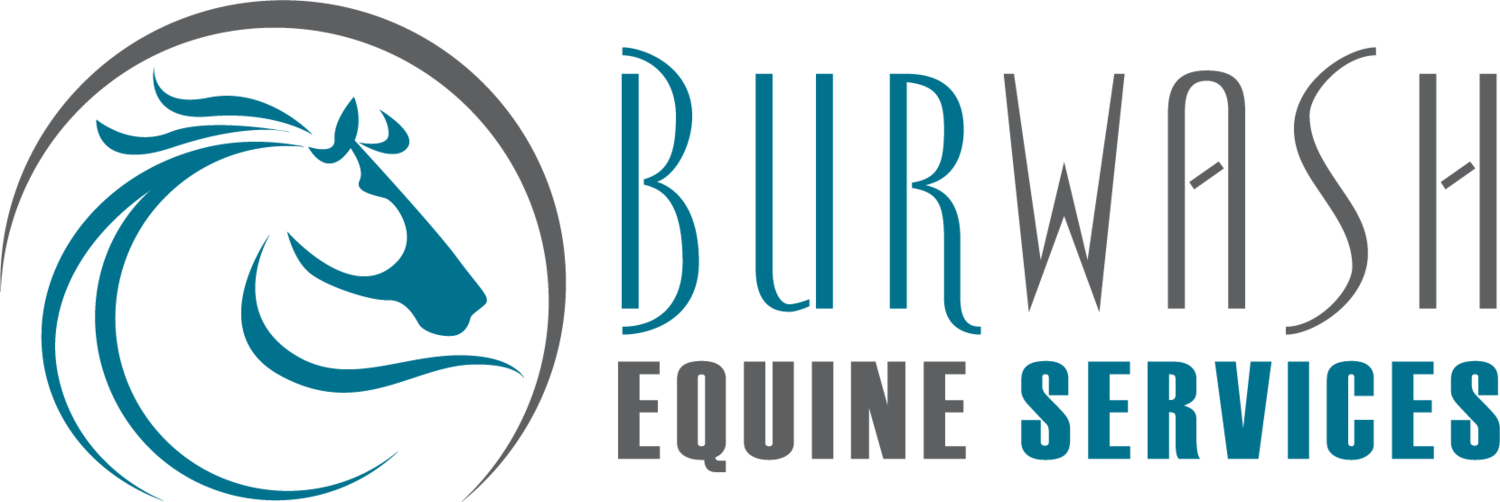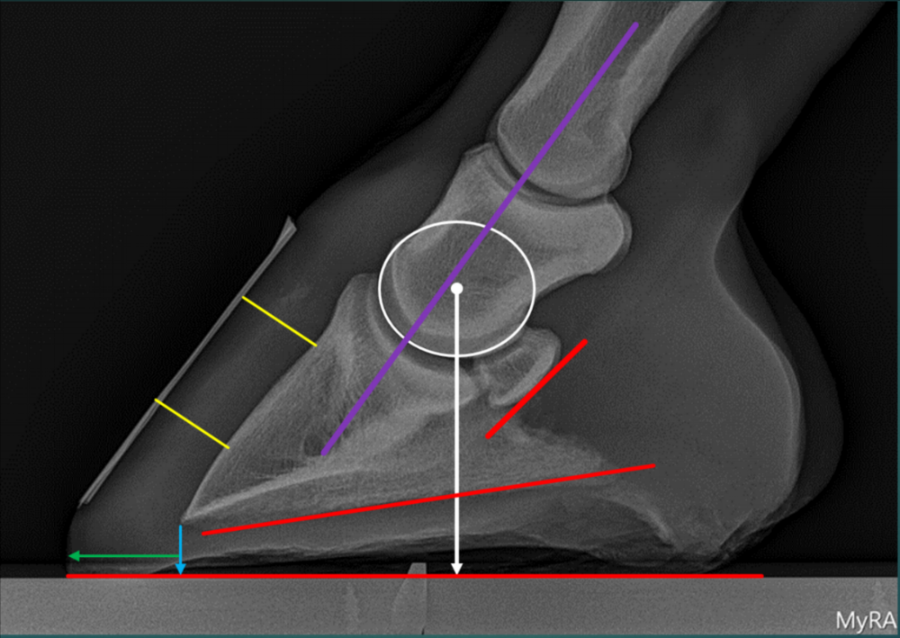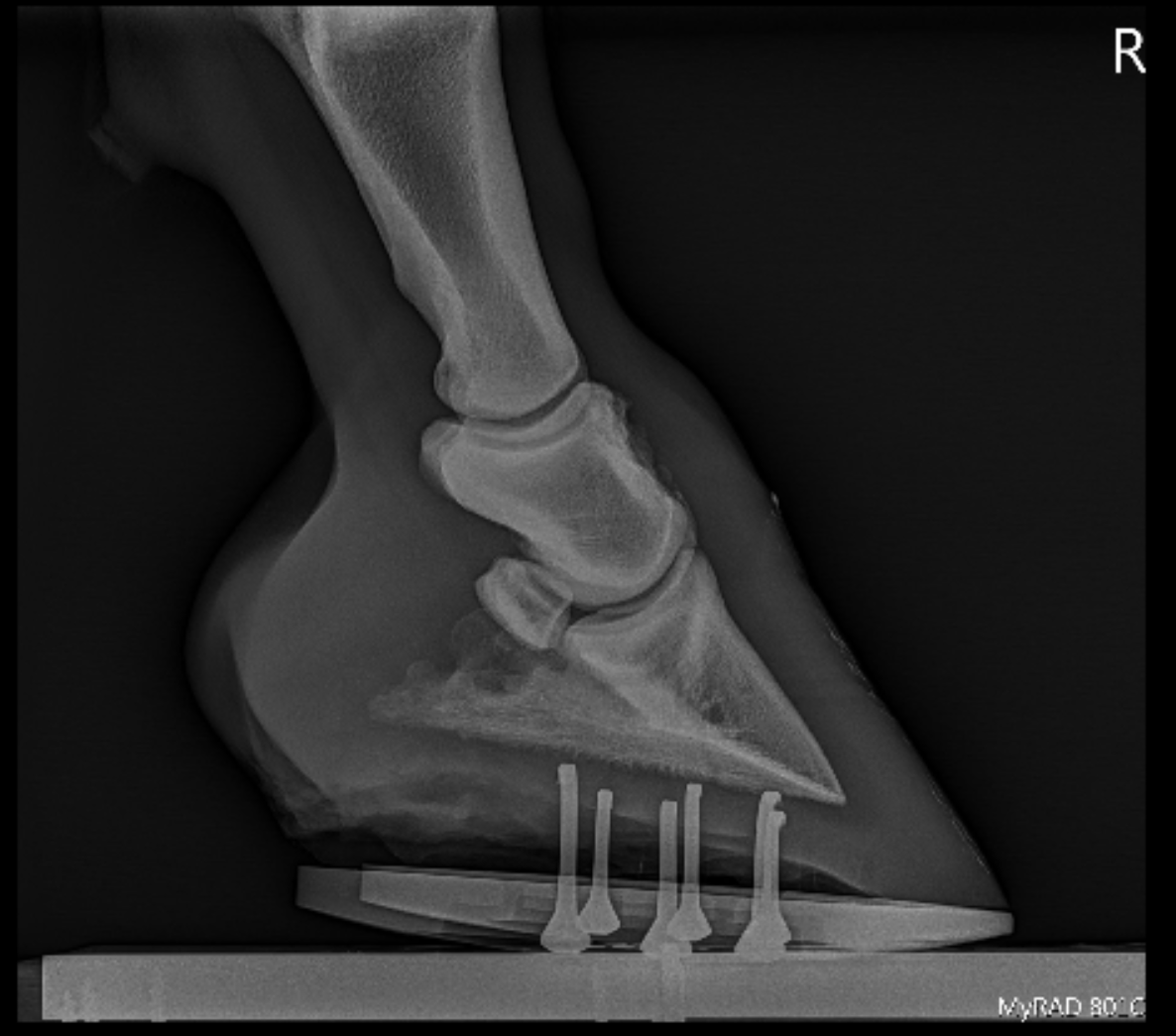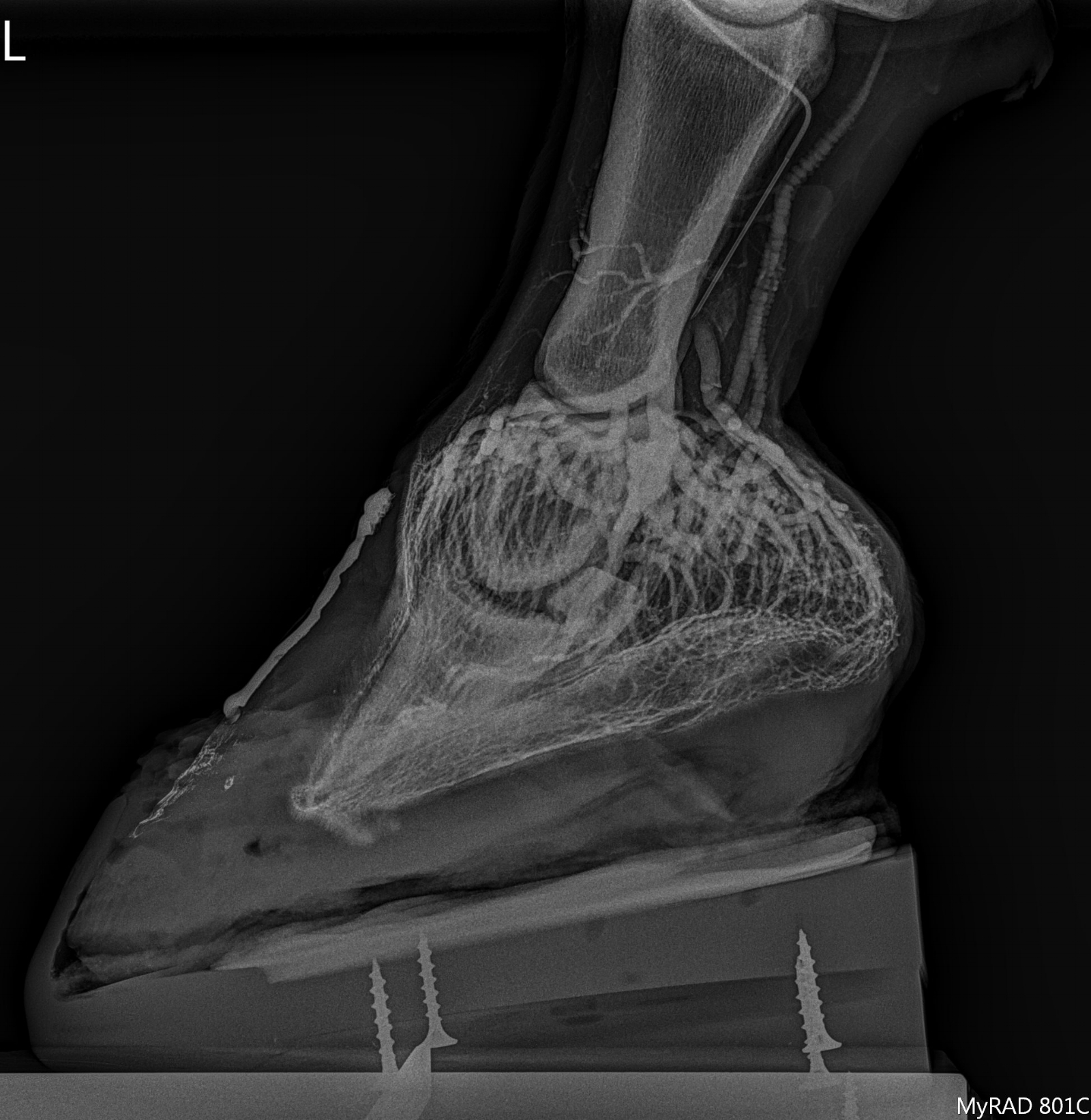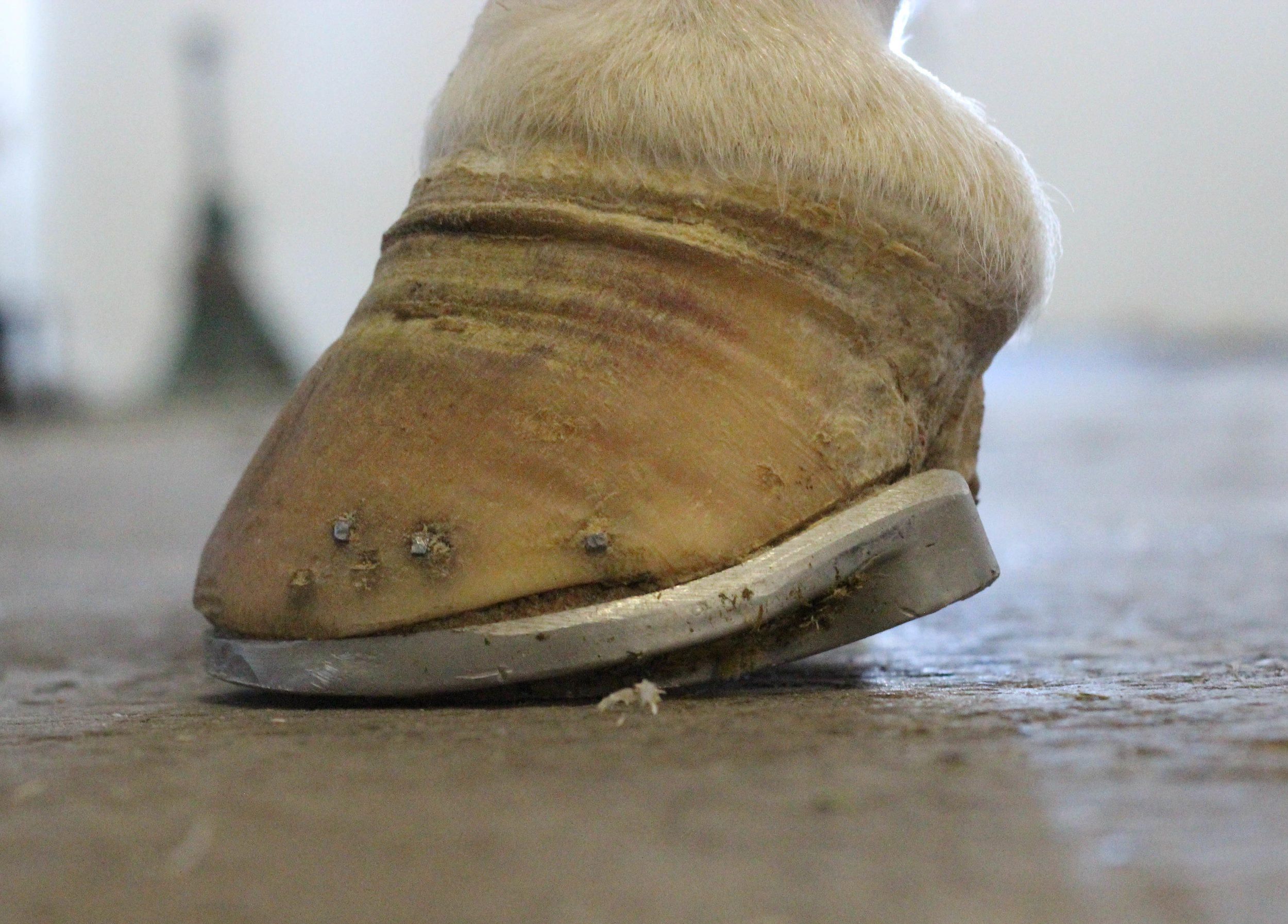Equine Podiatry
The traditional saying "no foot, no horse" couldn't be more true.
It is simply amazing to consider all of the functions that are occurring in the foot to support a horse's size and weight. However, this design is not without fault and is a region that is prone to injury and disease. Given the complicated nature of the functions occurring within the foot, it is helpful to have someone on your team with advanced knowledge in this area, and an understanding of the biomechanics involved, when faced with the challenge of dealing with a problem in the foot. We can make a world of difference in a horse's life and athletic career by optimizing the biomechanics of the foot.
The importance of a good client-veterinarian-farrier team approach cannot be stressed enough. Burwash Equine Services works side by side with Kirk Shaw of Equine Unlimited on many of our more challenging podiatry cases.
This diagram outlines all of the valuable information that can be gained from low-beam podiatry x-rays of a horse's feet.
Shoeing survey radiographs
Having routine low-beam podiatry x-rays performed on your horse's feet can help to detect problems early and allow appropriate adjustments to be made to the trimming and shoeing plan to prevent problems in the future. These radiographs are of similar benefit as taking your car to the mechanic for a wheel alignment or checking the tire pressure to prevent a flat tire. Our thoughts and ideas about how the bone is oriented inside the foot are often quite different than what we see on radiographs. These x-rays are a worthwhile investment, especially for top prospects and performance horses.
corrective farriery
Optimizing the biomechanics in the foot is the goal of any corrective farriery work. Low-beam podiatry radiographs are used to guide decisions for trimming and shoeing to allow the foot to function as ideally as possible. Corrective farriery is typically necessary in cases of underrun heels, club feet, navicular disease/caudal heel pain, chronic laminitis, and high or low ringbone. Examples of corrective farrier techniques that are considered in these cases include rocker rail shoes, full rocker motion shoes, shoes with heel kickers or positive pressure frog support, or more traditional shoes with wedge pads.
The horse in the above image was shod in a full rocker motion shoe to help both his caudal heel pain and his ringbone. He improved from a grade 3/5 lameness to a grade 1/5.
The specimen in this picture highlights the lamellae that are found under the dorsal hoof wall and that would serve to form the attachment of the coffin bone inside the foot to the outside hoof wall.
The above image is a venogram taken of a horse with acute laminitis after placement of a modified ultimate shoe system.
This horse was suffering from a severe episode of laminitis and was fitted with rocker rail shoes after spending 2 months in modified ultimates. She is currently sound.
laminitis & Venograms
Laminitis is a devastating disease affecting the horse's foot. The exact mechanism by which it occurs is still up for debate, but in this disease, there is inflammation of the lamellar attachments that hold the coffin bone inside the foot to the outside hoof wall (think of this attachment like velcro). When this "velcro" becomes inflamed, it weakens the attachments and they can start to tear, causing the bone to tip away from the hoof wall. As the bone tips away from the hoof wall, it causes compression of the small blood vessels that supply blood to the dorsal hoof wall and the sole. The goal with all of our podiatry techniques for addressing laminitis is shifting the weight bearing load away from the toe, where the blood supply is compromised, to the heel where better blood supply typically exists. One of the best methods of assessing the blood supply to the foot (also known as perfusion) is through the use of a venogram. A venogram is a procedure that involves injection of radiopaque dye (dye that shows up as white on an x-ray) into the blood vessels that supply the foot. Several radiographic views are then taken and interpreted to evaluate the degree of compromise to the perfusion of the foot. This information can then be used to guide treatment decisions from therapeutic farriery to surgery, and to indicate what the horse's prognosis for recovery is. The best time to act on a case of laminitis is the moment that you suspect that is what is going on. The quicker that laminitis can be treated and the biomechanics of the horse's hooves adjusted, the better chance the horse has of regaining soundness and living a happy and productive life. Acute cases (those that have just occurred) are often managed with the use of modified ultimate shoeing systems that when appropriately placed serve to shift the weightbearing load to the heel and decrease the pull of the deep digital flexor tendon on the coffin bone. Chronic cases (those that have been going on for some time) often require the use of rocker rail shoes. In more severe cases, a tenotomy (surgical transection) of the deep digital flexor tendon may be required to restore normal orientation of the bone within the hoof and restore more normal blood flow to the foot.
If you're interested in more detailed information on equine podiatry, please watch the video from our fall seminar, where Dr. Kirby Penttila discusses the foot in more detail. Please don't hesitate to call if you think your horse would benefit from her podiatry expertise!
testimonials
Pearl has become a new horse. There has been such a significant change in her demeanour it is hard to believe she is the same horse as when we first attended at Burwash with her. We believe her life had become intolerable because of the pain she was in due to laminitis. Regretfully, we spent years working with a farrier trying to alleviate the problems but to no avail. Now in hindsight we wish we would have started Pearl’s treatment at the clinic when she had her first occurrence of the laminitis in 2010. Undoubtedly, this early treatment working with your clinic would have saved Pearl considerable pain and discomfort through the series of bouts she had to endure while we were working with the farrier. One episode was so bad we considered euthanasia.
As far as commenting on the experience working with Burwash, the following thoughts come to mind:
• We really liked the scientific/fact based approach to their treatment of laminitis using xrays to properly place the rocker shoes. Her progress was notably visible with each visit. It was reassuring to review the xrays and compare her monthly progress and discuss each step of her treatment going forward with Kirby.
• A big part of the success with Pearl was Burwash’s recommendation to develop a proper diet which included checking hay analysis to obtain the proper hay and determining the right quantity of feed. Pearl has metabolic syndrome which requires constant monitoring of her feed and weight.
• Having our own farrier attend at the Burwash clinic to discuss Pearl’s condition and to see Pearl’s process as it moved forward has been a significant help in her recovery as well.
Pearl is still shod, her weight is now on track, she looks good, feels good, and is very calm and content. We are hopeful that over the next six to eight months she will not require shoes.
As a general comment we gained significant confidence in your services with your work on “Spud” where in my opinion went above and beyond professionalism and most of all patience. Even though we live south of Okotoks and need to take the day off work to bring our horses to your clinic, you are our “Vet of Choice”
Derra & Brent
